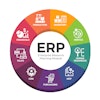
We all have witnessed how tough the past three years have been on supply chains. Multiple unforeseen events, many resulting from the COVID-19 pandemic, have driven organizations to become more agile and resilient. Maritime congestion, raw material shortages, remote working, and labor challenges have especially impacted supply chain-focused businesses. Those organizations that had at least some digital processes in place managed to navigate problems and minimize the downside of disruptions.
Digital transformation is no longer a nice-to-have
Complete digital transformation in the supply chain is a process, not an event. Ideally, it would be driven by a strategic plan for the organization. In practice, it often means achieving part or full digitization of the most critical processes in an organization and expanding from there. The benefits of digitization are speed, accuracy, and cost. Strategic decisions can be made faster and with confidence, and operational efficiency is vastly improved. Excel spreadsheets, emails, and messaging apps encourage working in silos and side channels, making collaboration difficult and inefficient. Lack of data visibility and poor insight across your supply chain is slowing down your speed to market and restricting your ability to drive the business forward. The absence of immediate access to reliable, accurate data and the drawbacks of error-prone manual methods are limiting opportunities for innovation and continuous improvement. Businesses need access to top-quality data, in real time, to stay competitive.
How does digitization work?
Digitization tools convert data, including transactional records and images, into a digital format. Once verified, this information can be used to upgrade and streamline processes, eliminating the need for paper-based documents and face-to-face interactions.
Digitization using technology tools provides transparency and visibility. Data visibility means being able to track and trace products and orders throughout the supply chain from sourcing to delivery. The latest Software-as-a-Service (SaaS) platforms can easily integrate and complement legacy enterprise resource planning (ERP), product lifecycle management (PLM), and other systems. Your business needs a single source of truth, replacing siloed ways of working and achieving end-to-end transparency.
Key focus areas when digitizing supply chain processes
1. Engaging the leadership
Success in any system implementation is alignment with business strategy. Collaboration with all stakeholders is vital to ensure that the chosen solution will both work and enjoy a high level of adoption. Involving leaders and engaging a top executive is more than getting the project approved and sponsored; it is about guaranteeing active participation during the process. It is also about ensuring that there are adequate resources allocated throughout the entire project.
2. Real-time cloud-based solutions
The “cloud” is where data will be stored. The International Data Corporation (IDC) predicts that 175 zettabytes will be stored in the cloud by 2025. One zettabyte is approximately equal to 1 billion terabytes.
Three key segments make up the cloud computing market — SaaS, Infrastructure-as-a-Service (IaaS), and low-code platforms. Together, these segments allow users to access software, store data, and develop new apps 100% remotely. According to the latest forecast from Gartner, Inc., in 2023, end-user spending on cloud computing is expected to reach nearly US$600 billion. Gartner forecasts a 23.2% growth for low-code platforms in 2023.
3. Low-code technology
A low-code platform makes it easier for customers, end-users, in-house IT teams, and other stakeholders to manage their software solutions in a more efficient and streamlined way. Low-code platforms do run on code, it’s just that the end user doesn’t need to use that code. Instead, vendors create low-code environments that hide the detailed code behind simple interactions and interfaces that customers are already familiar with. Here’s how they work:
- The approved user identifies a new requirement or a change that they want to make
- The user, or their in-house IT team member, can simply use drag and drop, sorting, filters, and other features to make changes.
- The changes are tested by the user to ensure they work as expected.
- Then the changes are made “live” and they take effect immediately.
This removes the need to involve the vendor in effecting changes, saving time, money and bringing agility to the business.
The power of data and analytics
Supply chains generate mountains of data at every step from sourcing the products from suppliers through to the final delivery to the customer. Data is generated in many sub-systems and formats, from many locations, and must be combined in a meaningful way. Aggregating large files of unstructured data can be difficult and slow but connected data is the key to success. Capturing data at every touchpoint and knowing what to do with the data is the first step.
Data only becomes useful when it is converted into meaningful information and leads to the right decision-making. Quality decisions cannot be achieved if data is incomplete, inaccurate, or stale. Using data analytics tools, you can extract valuable insights in real time to identify potential bottlenecks, and improve efficiency and overall productivity. All these benefits will enhance customer satisfaction and provide a competitive advantage. The increasing need for real-time data analytics has meant more entrants into the market, providing more advanced predictive analytics services. Data analytics has become a strategic priority within supply chains, but the process is complex and time-consuming without the support of the right solution.
Metrics that matter
Every company has different supply chain objectives, so what activities they choose to track and measure may vary. Some of these are elements that can be used for a balanced scorecard.
o Supply chain metrics. Capture critical data points along the supply chain about supplier performance, factory locations, product development, quotations, audits, inspection, order, shipment, and delivery.
o Sustainability data. Chemicals, factory workers’ health and safety, carbon emissions, greenhouse gas (GHG) emissions, water usage, packaging, and other key sustainability metrics are of utmost importance to measure, analyze, and share.
o Economic conditions. Costs, asset and inventory tracking, and sales data are just a few of the important economic data points that should be captured.
Key pitfalls to avoid while implementing digital solutions
· Missing alignment. Not aligning a proposed solution with business strategy. Collaboration with stakeholders is vital to ensure there are no siloed ways of working. Where business goals are not clear, the project will not achieve success. Determine your processes, technical and system needs, timelines, budget, and requirements that align with your business strategy.
· Lack of engagement from business leaders. It is not just about getting the project approved/sponsored but you also need leaders and stakeholders to participate in the process.
· People readiness. Resistance to change is the top impediment to a successful digitization project. Educating and training the team is a key part of a successful outcome.
· Absence of structured plan. Not enough attention is given to the time plan and establishing milestones.
· Resources. Underestimating the need for dedicated resources. A dedicated executive and transformation resources must be approved and allocated to the project.
· Selecting the wrong technology provider. This is the most important thing any business should avoid when planning any digital transformation.
According to Boston Consulting Group, the global business consultancy, only about 30% of companies navigate a digital transformation successfully. Only about 30% of companies navigate a digital transformation successfully. Ensuring that transformations are introduced incrementally, while keeping a sharp focus on cost-effectiveness and long-term viability, is the key to success, according to Boston Consulting Group.




















